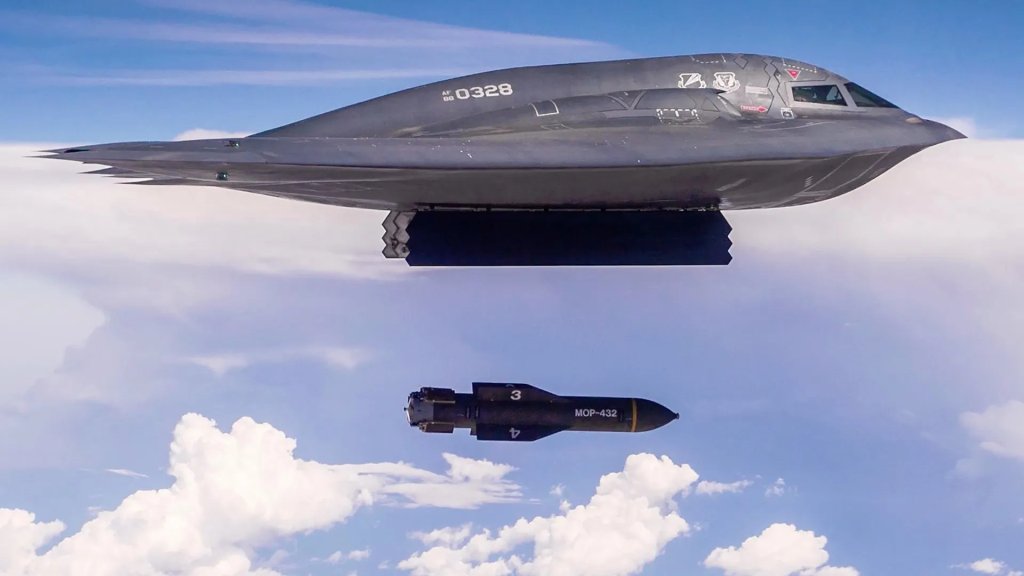New Fuzes For GBU-57 Massive Ordnance Penetrators Requested By USAF
The USAF is looking for options to improve and expand its arsenal of MOPs, which were used for the first time recently to strike Iran.
Joseph Trevithick - TWZ Jul 7, 2025
The U.S. Air Force is exploring new options to help with the development of improved fuzes for the 30,000-pound GBU-57/B Massive Ordnance Penetrator (MOP) bunker buster bomb. The service is also interested in additional sources for the production of other key GBU-57/B components, as well as assistance in sustaining its current stocks of the bombs. This follows the first combat use of the MOP in strikes on Iranian nuclear facilities last month.
The Air Force Life Cycle Management Center (AFLCMC) put out a contracting notice regarding potential GBU-57 production and support needs earlier today. The total size of the existing MOP inventory is classified, but Air Force Chief of Staff Gen. David Allvin said at a hearing before members of the Senate Appropriations Committee on June 26 that it is currently being expanded. At present, the B-2 stealth bomber is the only aircraft cleared to employ the massive bunker buster operationally, and can carry just two of them per sortie. The B-21 Raider stealth bomber is also expected to have the MOP in its arsenal, but it’s likely it will only be able to carry one of the bombs at a time. B-52s have been used to drop them during testing, as well.
“Fuze development and integration into the components of the GBU-57 weapon system, to include integration and software modification within the KMU-612 tail-kit and the BLU-127 fuzing system,” is among the stated areas of interest in the contracting notice.
The KMU-612/B, of which there are many variants already, is the tail section of the GBU-57/B, which contains the GPS-assisted inertial navigation system (INS) guidance package and other systems. The BLU-127/B is the penetrating “warhead” that is combined with the KMU-612/B and other components to form a complete MOP.

A B-2 bomber drops a GBU-57/B Massive Ordnance Penetrator (MOP) during a test. USAF
“Fuze development and integration into the components of the GBU-57 weapon system, to include integration and software modification within the KMU-612 tail-kit and the BLU-127 fuzing system,” is among the stated areas of interest in the contracting notice.
The KMU-612/B, of which there are many variants already, is the tail section of the GBU-57/B, which contains the GPS-assisted inertial navigation system (INS) guidance package and other systems. The BLU-127/B is the penetrating “warhead” that is combined with the KMU-612/B and other components to form a complete MOP.
The contracting notice also lists the production of KMU-612E/B variants of the tail kit, production of other unspecified MOP components, sustainment support (“to include, but not limited to: support of all MOP hardware and support equipment; MOP tail kit repairs/retrofits; and MOP Engineering Technical Support”), and “obsolescence support and validation,” as areas where the Air Force is looking for new assistance.
“This Sources Sought is for informational planning purposes and it is not to be construed as a commitment by the Government for any actual procurement of materials, machinery, or services,” the notice also stresses. “This notice does not constitute a solicitation or a promise of a solicitation in the future. This Sources Sought does not commit the Government to a contract for any supply or service.”
The strikes on Iran in June have put a new spotlight on the GBU-57/B and made the bombs something of a household name. The need for an option to hold the Iranian nuclear enrichment facility at Fordow at risk without having to resort to using a nuclear bomb was central to the bomb’s original development. You can read more about the munition’s backstory in our recent interview with a retired Los Alamos National Laboratory (LANL) scientist who took part in testing that led up to the MOP program here.
The MOP has been upgraded multiple times already since the munition first began entering service in the early 2010s, particularly with regard to its fuzing. This is an especially important aspect of the bunker buster’s design, as TWZ has noted previously:
“Reliable fuzing, in general, is particularly important for bunker buster bombs, the components of which have to be able to withstand additional forces as the munition burrows through hard material.”
“Bombs like the MOP … that are designed to penetrate very deeply have additional specialized fuzing needs, especially for employment against targets where pre-strike intelligence about the exact depth and/or physical layout is limited. Work on advanced void-sensing fuzes that can detect when a munition has breached into a sufficiently large space, such as a room in an underground facility, is an area of development that has already been of particular interest for the U.S. military for years now. A fuze that is able to just effectively ‘count’ floors to help determine depth to detonate the bomb at a certain level for maximum damage would also be a useful addition.”
The capabilities offered by the existing fuzes for the MOPs were on full display in the strikes on Iran, according to the Pentagon.
Each of the 12 MOPs dropped on Fordow had their “fuze programmed bespokely” allowing “each weapon to achieve a particular effect inside the target,” and all of the bombs “had a unique, desired impact angle, arrival, [and] final heading,” Chairman of the Joint Chiefs of Staff U.S. Air Force Gen. Dan “Razin” Caine explained at a press briefing on June 26.
At Fordow, B-2 stealth bombers also notably dropped all of the MOPs on just two impact points, with six bombs striking each one, successively burrowing down to the actual target below. Though the Pentagon has said the overall mission was a resounding success, the actual immediate results of the strikes and their broader impacts on Iran’s nuclear ambitions remain major points of contention. At the time of writing, the U.S. military’s most recent public assessment is that the Iranian nuclear program has been set back between one to two years, but the International Atomic Energy Agency (IAEA) has said domestic enrichment activities could resume in the country within a matter of months.

A graphic shared at the press conference today with additional details about the employment of MOPs on Fordow. DOD
Regardless, any further improvements to the GBU-57’s fuzing arrangement or other aspects of the design will now benefit from lessons learned from the employment of the munitions on targets in Iran. The combat use of the MOP has also offered Iran and other potential adversaries (including Russia and China, which have strong relations with the regime in Tehran) an opportunity to try to glean key details about the bombs. Additional upgrades and modifications to the MOP could then be required to account for any attempts to devise countermeasures to its existing capabilities.
The unique deep-penetrating conventional strike capability offered by the MOP, paired with the B-2 (and the future B-21), could be called upon in future conflicts well beyond Iran. China and Russia both have well-established histories of building deep underground facilities, including mountain caverns for aircraft and submarines, and continue to expand their subterranean infrastructure. North Korea has also been pushing to grow its underground capabilities, in no small part due to the threat of U.S. strikes.
“This is not a static environment,” Allvin also said at the June 26 hearing before the Senate Appropriations Committee. “Now that we know that it was successful, I’m pretty sure that people who are potential adversaries might look at that and they may adapt.”
Allvin was responding to a direct question about whether a replacement for the MOP is in development. The Air Force is working on a successor design, currently referred to as the Next Generation Penetrator (NGP), which could evolve into a family of munitions, if it has not begun to already.

A 2010 US Air Force briefing slide discussing plans for a Next Generation Penetrator and other future bunker busters that could be part of a single family of munitions. USAF
“So, we are constantly looking at, whether it be those [MOP replacement options], or an advanced technology, or advanced tactics, to be able to get ahead and make sure, as the threat moves to defend, we have the ability to put the kit together that we can continue to have events like last Saturday night happen if we’re called upon again,” Allvin added at the hearing last month, referring to the strikes on Iran. “It might be something different than the GBU-57, some advancement based on what the enemy might do.”
In the meantime, the strikes on Iran have only cemented the importance of the GBU-57 and of ensuring those bombs remain as capable as possible of holding especially deeply buried targets at risk.☀
Joseph Trevithick Avatar
Joseph Trevithick Deputy Editor
Joseph has been a member of The War Zone team since early 2017. Prior to that, he was an Associate Editor at War Is Boring, and his byline has appeared in other publications, including Small Arms Review, Small Arms Defense Journal, Reuters, We Are the Mighty, and Task & Purpose.







